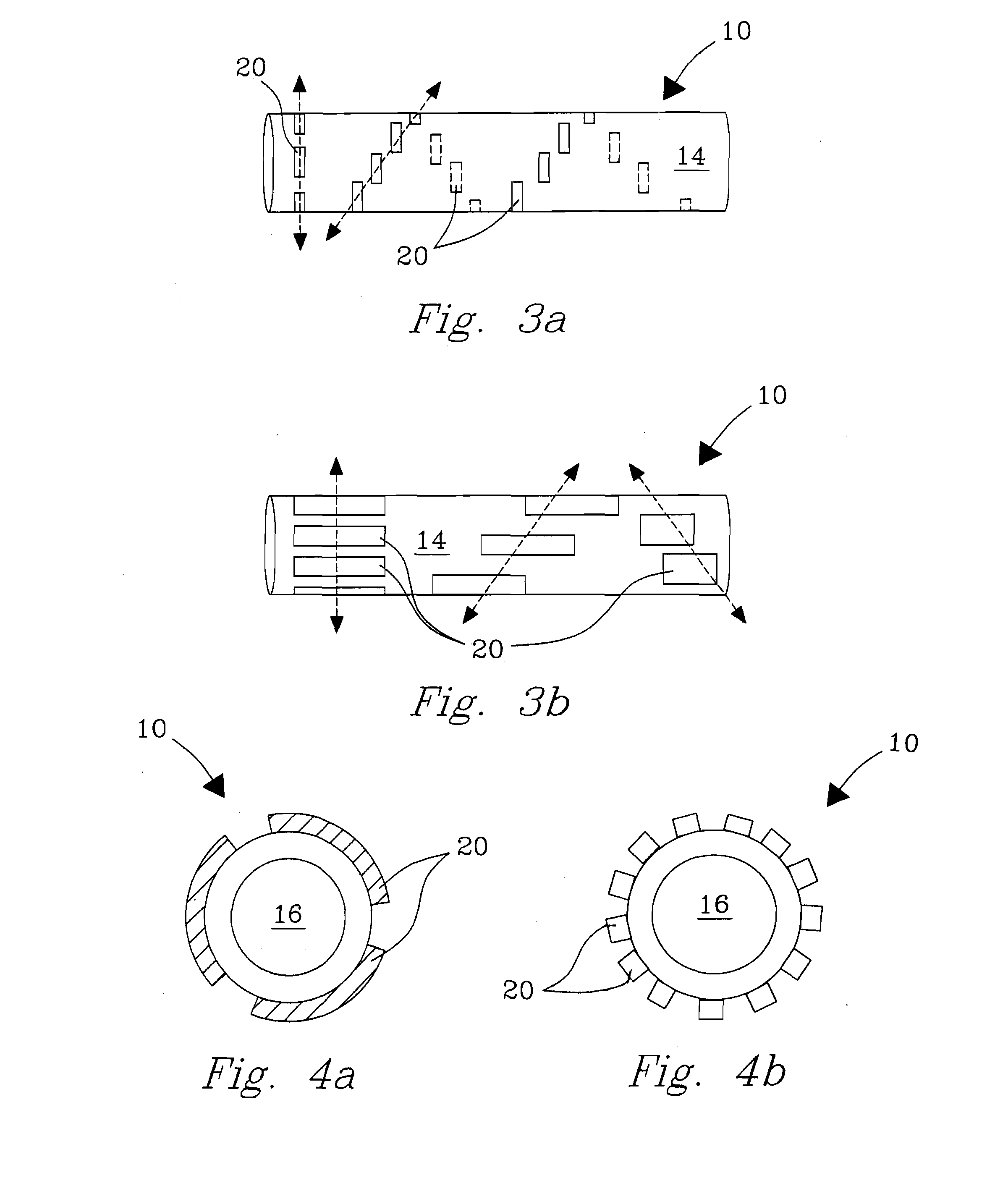Device and method for noninvasive ultrasonic treatment of fluids and materials in conduits and cylindrical containers
- Summary
- Abstract
- Description
- Claims
- Application Information
AI Technical Summary
Benefits of technology
Problems solved by technology
Method used
Image
Examples
example 1
(Exemplary Operating and Processing Conditions)
[0041]In an exemplary, non-limiting processing operation, the PZT rings were powered by a commercially available 50-ohm arbitrary output waveform function generator (Hewlett Packard, Palo Alto, Calif., USA) and a commercially available 50-ohm output radio frequency (RF) power amplifier (Electronics & Innovation, Rochester, N.Y., USA). The function generator was tuned to provide a continuous or pulsed sinusoidal wave of a predetermined frequency and voltage. Output signal from the function generator was provided to the input of the RF power amplifier where it was amplified before being supplied to the PZT rings. The PZT rings were wired in parallel to deliver a uniform voltage.
[0042]A perpetual mismatch was observed between the 50-ohm electronics and the inherent electrical impedances of the PZT rings at their resonance frequencies (i.e., the load). This impedance mismatch affected overall efficiency of the system, requiring the amplifie...
example 2
(Static Mode Processing of Mexican Crude Oil)
[0045]A low grade, heavy (i.e., 12.67 API) Mexican crude oil was processed in static mode 1) at resonance frequencies of 625 kHz (thickness mode) and 90 kHz (length mode) and 2) off-resonance frequencies of 80 kHz, 700 kHz, and 825 kHz. In the preferred embodiment of the invention configured for static processing of crude oils, container 10 had a wall thickness of 3.264 mm and a length of 20.71 mm. PZT rings 20 had dimensions of: 62.23 mm O.D.; 55.63 mm I.D. Outerwall 14 was constructed of a 64 mm O.D. Schedule-40 carbon steel pipe segment, chosen due to its use in crude oil production piping. Three (3) PZT rings were mounted on the outside of the pipe segment. Temperature data during static sonication of the crude oil are presented in Tables 1 and 2. Viscosity data are presented in Table 2. FIG. 7 plots changes in temperature of the crude oil in the center axial zone of the reactor as a function of sonication time.
TABLE 1Temperature Prof...
example 3
(Dynamic Flow Processing of Alaskan Crude Oil)
[0051]A heavy Alaskan crude oil (19 API), characterized as a 38 wt % brine-in-crude oil emulsion, was sonicated in the flow loop of the test configuration that contains the adapted crude oil processing technology (herein frequently referred to as the “test leg”) under dynamic flow processing conditions. The flow loop 10 was constructed of a 49.8 mm O.D. Schedule-40 carbon steel pipe. The flow loop comprised eighteen (18) PZT rings 20, but is not limited thereto. In the instant configuration, the PZT rings used for the flow loop were of a slightly different dimension than those used for static processing described in Example 2, including a 61.0 mm O.D.; 48.8 mm I.D.; 6.096 mm wall; and 30.48 mm length. Rings of the test leg were spaced 25.4 mm to 27.9 mm apart (i.e., at least 1.5 wavelengths at 65 kHz) to ensure constructive overlap of the sonicated volumes produced by neighboring rings. A 114 L (30 gallon) sample of the low grade, heavy ...
PUM
 Login to View More
Login to View More Abstract
Description
Claims
Application Information
 Login to View More
Login to View More - R&D
- Intellectual Property
- Life Sciences
- Materials
- Tech Scout
- Unparalleled Data Quality
- Higher Quality Content
- 60% Fewer Hallucinations
Browse by: Latest US Patents, China's latest patents, Technical Efficacy Thesaurus, Application Domain, Technology Topic, Popular Technical Reports.
© 2025 PatSnap. All rights reserved.Legal|Privacy policy|Modern Slavery Act Transparency Statement|Sitemap|About US| Contact US: help@patsnap.com



